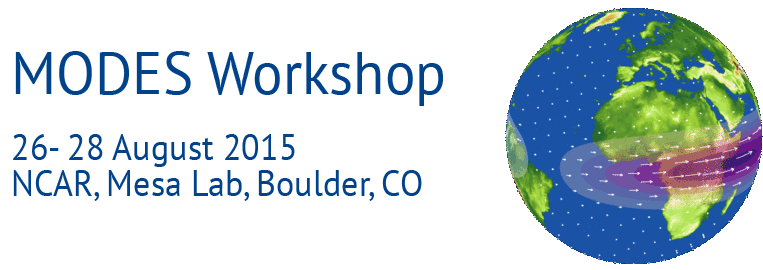2015 MODES Workshop
Purpose
The central theme of the workshop is the normal mode functions and their application in numerical weather prediction and climate research.
Motivation & Objectives
The dynamics of weather and climate can be discussed as the adjustment process to a predominantly balanced state that is horizontally geostrophic and vertically hydrostatic. This notion best applies to the midlatitudes where geostrophic balance between the mass and wind fields prevails to a greater degree especially on large scales. In the tropics such a balance only weakly holds; here intense ageostrophic motions can occur in the troposphere through moist convection. While the midlatitude dynamics is well described by the quasigeostrophic or Rossby-type motions, in the tropics the inertiogravity motions dominate on all scales. These two types of motion can be analyzed by means of solutions to the linearlized primitive equations of the atmosphere. Known as normal modes, Rossby and inertiogravity modes have been extensively applied for the initialization of numerical weather prediciton models in 1980s. The global horizontal structures of normal modes, known as Hough functions, have been used to study various atmospheric dynamical phenomena in weather and climate. Historically, the basic properties of the large scale circulations in the tropics for both the atmosphere and oceans have been elucidated in terms of normal modes on the equatorial beta plane. The equatorial Kelvin, the mixed Rossby gravity and the equatorially trapped inertiogravity and Rossby modes, characterized by small phase speeds, are known to be associated with the most energetic modes of tropical variability in observations and analyses and in weather and climate models.
The workshop reviews various developments of normal mode theory and its application to weather and climate research over the past few decades.
Workshop Structure and Agenda
The workshop will consist of a combination of invited talks, contributed talks and poster presentations. Also, the workshop will be a venue of discussion on the prospect for using the Hough vector harmonic representation of the global 3-D mass and velocity fields, inspired by the pioneering work of Akira Kasahara, as a tool for the analysis of modern NWP and climate model outputs to complement the broad ideas of modes of atmospheric variability defined in terms of EOFs and similar statistical functions.
Tutorial
MODES is a free-access software developed within the project "Modal analysis of atmospheric balance, predictability and climate". Based on the theoretical development by Kasahara and Puri, the software allows diagnosis of properties of balanced and inertio-gravity circulation in global 3D datasets. The workshop ½ day tutorial will provide introduction to the use of software and its application to reanalysis datasets.
